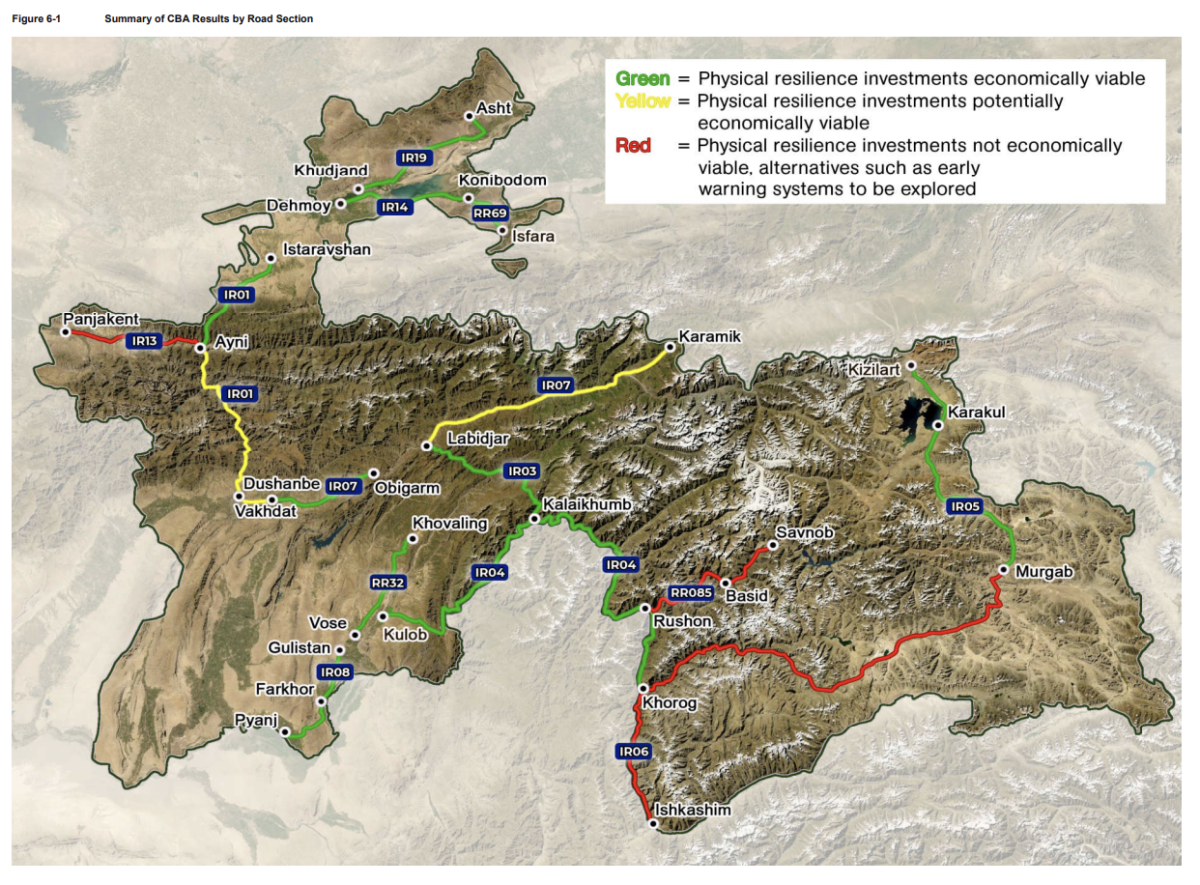Assessing the Economic Impacts of Disasters along Key Transport Corridors: Tajikistan

Summary
This World Bank and Global Facility for Disaster Reduction and Recovery (GFDRR) project combined surveys, interviews, and extensive site visits to assess the economic impact of both natural disasters and climate change on Tajikistan’s primary road network. It aimed to identify high risk sites and recommend a range of mitigation measures that could be taken to reduce the risk and effects of particular natural hazards, including flooding, landslides, avalanches, rockfalls, and mudflows.
Natural disasters and climate change threaten Tajikistan’s economic and social development. The country’s varied geological, climatologic, and topographic features exacerbate its vulnerability, making it highly susceptible to many natural hazards, including earthquakes, floods, landslides, and avalanches. Natural disasters cause both short term and long-lasting damage to infrastructure, economic activity, and social wellbeing. Between 1992 and 2016, economic losses from natural hazards in Tajikistan exceeded $1.8 billion and affected almost 7 million people.An important aspect of this study was to assess how climate change will impact the number and severity of future disasters. This is particularly important in a country such as Tajikistan where the impact of climate change will vary between regions and will affect different hazards in different ways. Overall, it is estimated that the number of disasters affecting the road network will rise by 3% per annum over the next 10 years.
This study, financed by theJapan-World Bank Program for Mainstreaming Disaster Risk Management in Developing Countries, quantified the economic costs of disasters that affect the country’s major road network. To justify increased investment in the road network, specifically to increase the level of disaster resilience, it is important to have a clear understanding of these costs and the potential to reduce them.
The geographical scope of the assignment comprised selected key corridors including republican roads across Tajikistan (approximately 2,000 km), focusing on national and international trade corridors and links with neighbouring countries. At the same time, the assessment focused on areas of the country with greater risks from natural hazards.
Overview
- Location:
- Implementation sites:
-
- Single country
- Multiple locations
- Mountain region:
-
Pamir Mountains
- Province:
-
- Sughd; Regions of Republican Subordination; Khatlon; Gorno-Badakhshan Autonomous Oblast
- Solution scale:
- Area Covered:
-
- 2,000+ kilometres of road network
- Ecosystem type(s):
- Solution type(s):
- Sector(s):
- Climate impact(s) addressed:
- Other climate impact(s) addressed:
-
- Debris flows; Rockfalls; Avalanches
- Climate impact time-scale(s):
- Main benefit associated with the solution:
- Co-benefit(s) associated with the solution implementation:
- Implementation timeline:
-
- 2020 - 2022
Solution details
Main beneficiaries & outcomes
Key beneficiaries of the project were the Ministry of Transport and local road maintenance departments. Further beneficiaries and outcomes of the project are somewhat dependent on which mitigation measures the Government of Tajikistan decide to implement.
Informed by this assessment – which concluded that the economic costs of disasters impacting Tajikistan’s road network are estimated at around 0.5% of GDP per annum, and are likely to rise by 3% per annum over the next 10 years due to climate change – the ‘Tajikistan Preparedness and Resilience to Disasters Project’ was approved by the World Bank. This will invest in strengthening the resilience of key infrastructure against natural hazards, better mitigating climate-related risks and enhancing the national capacity in disaster risk management and climate change adaptation. Specifically, the project aims to rehabilitate and reinforce bridges in Khatlon damaged during the 2021 floods and mudflows, as well as implement modern resilience approaches to protect the primary road of the Rasht Valley against natural hazards. The project will also finance trainings for professional search and rescue teams, public trainings for disaster preparedness and improved awareness about climate change, and development of disaster preparedness and climate adaptation modules for different stakeholders, such as public agencies, vulnerable citizens, industrial zones, etc.
Planning and implementation
This project consisted of 4 key activities:
- Road inspections were conducted to identify the locations within target sections that require implementation of mitigation measures. At each location an assessment was undertaken to identify the source of hazards, the potential impact and appropriate mitigation measures. 331 individual locations were identified and inspected across more than 2,000 km of the road network, highlighting hazards including flooding, landslides, avalanches, rockfalls and mudflows.
- Socio-economic surveys were carried out in the locations that, as far as possible, matched the locations of the road inspections. The surveys included a wide range of questions aimed at detailing the situation of surveyed households, as well as the impact of disasters on a range of socio-economic factors. These surveys were backed up by a series of key informant interviews. In total, 400 surveys and 15 key informant interviews were completed, giving a broad based view of the areas affected by disasters.
- Assessment of costs for the following categories: beyond just the effects on the infrastructure including potential loss of life, emergency response, reconstruction, disruption to local and international trade, and reduced access to critical services and markets leading to a loss of access to income opportunities and social, health, and educational services. In high-risk settings common in mountainous areas, successive and regular disasters often compound these impacts, and alternative routes are often not available or practical (limited road network redundancy).
- Cost benefit analysis (CBA) was then undertaken for the proposed programme of mitigation measures for the identified hazard sites. The results of the CBA show that as it is currently proposed, the full national programme of mitigation measures is not considered to be economically viable. This is in part due to the large costs attached to some of the measures on roads with limited traffic and only a small number of disasters. However, on some stretches of road, the proposed investments do make economic sense.

The Government of Tajikistan will determine which road resilience measures to prioritize and pursue. Noting that 100% resilience is an impossible target, the measures identified focus not only on eliminating a particular hazard (e.g. avalanche control fences), but also on mitigating the effects of the hazard (e.g. retaining walls to collect rockfalls). Suggested mitigation measures include flexible rock wall protection barriers; retaining walls; gabions to stabliise slopes; creation of embankments and culverts; drainage pathways; road realignment; snow fences; and avalanche galleries.
However, the report recommends that the solutions being implemented also consider further mitigation of risks, such as continued investment in improved search and rescue and emergency response capability in areas regularly affected by disasters. Equally important are investments in early warning systems to detect the early signs of a hazard occurring, to warn road users, affected communities and first responders to be ready for an event. These systems would help reduce loss of life and enable faster response times to disasters, as equipment and people will be more likely to be in the right place.
Finance
The assessment was financed by the Japan-Bank Program for Mainstreaming DRM in Developing Countries, which is financed by the Government of Japan and receives technical support from the World Bank Tokyo Disaster Risk Management Hub.
Innovation
Where appropriate, a range of innovative solutions have been suggested for hazard sites. Whilst some of these solutions will be new to Central Asia and Tajikistan, and some may not yet be included within relevant design standards, it is considered appropriate to include these within this analysis, as these new solutions represent the best options for dealing with identified hazards, also in consideration of cost efficiency and maintenance burdens.
Long term project sustainability and maintenance
This project took into account future climate change impacts which would in turn affect the frequency and severity of natural disasters. This could increase the long-term effectiveness of the mitigation measures. At the same time sufficient maintenance of roads and protection infrastructure is critical to ensure sustainability, but comes with recurrent costs that may be difficult to mobilize in resource-constrained contexts.
Capacities for design and implementation
Knowledge
Research was key to the development of potential solutions. The study used official statistics, 400 household surveys, and 15 key informant interviews, to determine the total economic damage due to disasters on the road network. The interviews with local stakeholders, ministries, departments, and regional road maintenance organizations show the importance of situated knowledge in calculating costs and developing potential solutions. A cost benefit analysis was also undertaken for the proposed mitigation measures to assess which would be economically viable across different regions.
Technology
To support the completion of the road inspection and collection necessary data on natural disasters, low-cost Earth observation data (e.g. satellite imagery, photographs from natural disasters) was used.
Outlook & Scalability
Barriers and adverse effects
The progress and conduct of the study were significantly affected by COVID19 related restrictions. Key impacts include the inability of international consultants to visit Tajikistan; COVID related illness affecting the local inspections team; Internal travel restrictions delaying the socio-economic surveys; Additional pressures on Government ministries leading to slower than normal response times; and overall delays to the project schedule.
Transformation and future outlook
A detailed analysis of secondary data sources has been undertaken as part of this study, to assess future patterns of the factors that lead to disasters. The aim of this was to highlight where factors may change over time, particularly highlighting differences in different parts of the country. This has resulted in a clear understanding of how climate change will affect different parts of Tajikistan and the disasters that affect different parts of the road network. Whilst in some ways Tajikistan may benefit as a result of climate change, issues such as increased glacial melt, changes to snow and rainfall patterns and a quicker transition into spring will result in gradually increasing numbers of disasters. These factors were considered in the projects’ assessments.
Whether or not the project supported fundamental change in climate change adaptation in the mountain region is highly dependent on which mitigation measures the Government of Tajikistan decide to implement, if any. Some mitigation measures were more expensive than others and thus may be less attractive. For example, the 65 proposed avalanche galleries cost on average over US$4 million each and would generally protect only very short (albeit critical) road points (on average 175 meters). On roads with limited traffic and/or only a small number of disasters, these kinds of investments simply do not produce enough economic return.
- Strengthening Critical Infrastructure Against Natural Hazards Project: Tajikistan
- Reducing climate change induced risks and vulnerabilities from Glacial Lake Outburst Floods in the Punakha, Wangdue and Chamkhar
- The Winter Preparedness and Avalanche Readiness Programme in Afghanistan, Pakistan and Tajikistan
- Creating Opportunities in a Safe Environment: Fostering Self-Sustained and Resilient Communities (COSE II)
- Building climate resilience of vulnerable and food insecure communities in mountainous regions of Tajikistan





Comments
There is no content